Uniden America UT644 PORTABLE VHF PTT MARINE RADIO TRANSCEIVER User Manual Rev
Uniden America Corporation PORTABLE VHF PTT MARINE RADIO TRANSCEIVER Rev
User Manual Rev
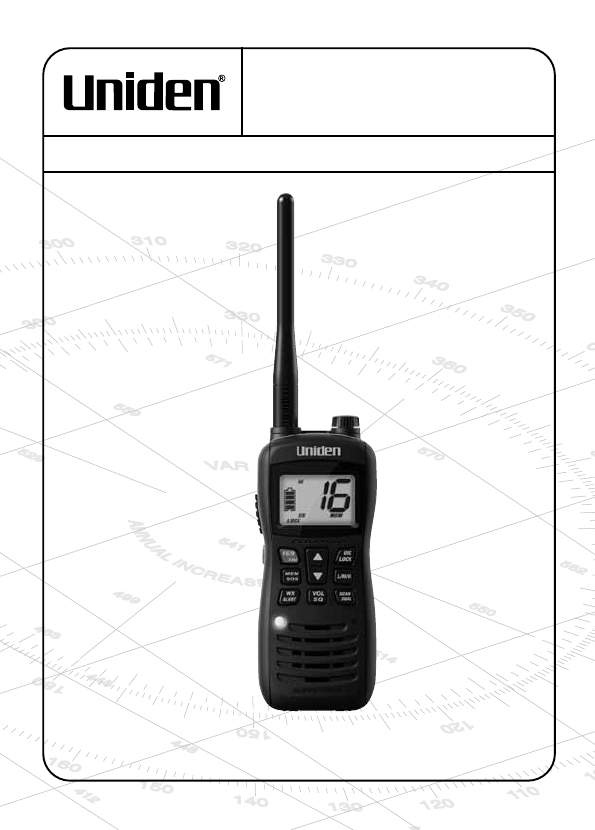
MHS126
RADIO VHF MARITIME
GUIDE D’UTILISATION
VHF MARINE RADIO
OWNER’S MANUAL

Making a Distress Call
Speak slowly - clearly - calmly.
For future reference, write your boat’s name & call sign here:
1. Make sure your radio is on.
2. On the radio, press the 16/9-Tri button to switch to Channel 16
(156.8 MHz). (If the corner of the display does not show 16, press
the 16/9-Tri button again until it does.)
3. Press the push to talk button and say: “MAYDAY -- MAYDAY --
MAYDAY.”
4. Say “THIS IS
{name of your boat (three times) and call sign/boat
registration number (once)}.
”
5. Say “MAYDAY
{name or call sign of your boat}.
”
6. Tell where you are: (what navigational aids or landmarks are near,
or read the latitude and longitude from your GPS).
7. State the nature of your distress, (e.g. are you sinking, medical
emergency, man overboard, on re, adrift, etc.
8. State the type of assistance you need (medical, towing, pumps,
etc.).
9. Give number of persons aboard and conditions of any injured
persons.
10. Estimate present seaworthiness of your ship (e.g. how immediate is
the danger due to ooding or re or proximity to shore).
11. Briey describe your ship, giving the ship name (e.g. “Blue Duck is
32 foot cabin cruiser, white hull, blue deck house”).
12. Say: “I WILL BE LISTENING ON CHANNEL 16.”
13. End message by saying “THIS IS
{name or call sign of your boat}
,
OVER.”
14. Release the push to talk button and listen.
If you do not get an answer after 30 seconds, repeat your call,
beginning at step 3, above.

Faire un appel de détresse
Faire un appel de détresse vocal
Parlez lentement – clairement – calmement.
Pour toute référence ultérieure, transcrivez ci-dessous le nom et l’indicatif
d’appel de votre bateau :
1. Vériez si votre radio est en marche.
2. Appuyez sur la touche 16/9-Tri de la radio an de commuter au canal 16 (156,8
MHz). (Si le canal 16 n’apparaît pas à l’afchage, appuyez de nouveau sur la
touche 16/9-Tri jusqu’à ce qu’il soit afché.)
3. Appuyez sur le bouton de microphone push to talk et dites :“MAYDAY - MAYDAY
– MAYDAY”.
4. Donnez l’identité de votre navire en disant : “ICI {nom de votre bateau (trois fois) ou
indicatif d’appel et le numéro d’identication de votre bateau (une fois)}”.
5. Dites “MAYDAY {nom ou indicatif d’appel de votre bateau} une fois”.
6. Donnez votre position : (quels sont les points de repère ou aides à la navigation
près de vous ou lisez les coordonnées de longitude et de latitude apparaissant sur
votre dispositif GPS).
7. Révélez la nature de votre détresse (par exemple, nous sommes en train de couler,
urgence médicale, un homme à la mer, un incendie, nous sommes à la dérive, etc.
8. Révélez la nature de l’assistance désirée (médicale, remorquage, essence, etc.)
9. Donnez le nombre de personnes à bord et les conditions des blessés, s’il y en a.
10. Donnez la condition de navigabilité actuelle de votre navire, tel que le degré de
l’urgence par rapport à l’inondation, à l’incendie ou à votre proximité de la côte.
11. Donnez une brève description de votre navire en donnant le nom du bateau (par
exemple, “Blue Duck est un yacht de croisière de 32 pieds, avec une coque blanche
et un roufe bleu.”).
12. Dites : “JE VAIS ÉCOUTER SUR LE CANAL 16”.
13. Terminez le message en disant “ICI {nom ou indicatif d’appel de votre bateau}, À
VOUS”.
14. Relâchez le bouton push to talk du microphone et écoutez.
Si vous n’obtenez pas de réponse après 30 secondes, répétez l’appel
encommençant à l’étape 3 ci-dessus.

Making a Distress
Call ............ (inside front cover)
Table of Contents
Introduction ............................ E-1
Features .................................. E-1
Getting Started ....................... E-4
What’s Included ....................... E-4
Parts of the MHS126 ............... E-5
Front view .......................... E-5
Back view ........................... E-5
Charger .............................. E-7
Reading the Display ................ E-7
Display icons and what
they mean ..................... E-8
How It Works .......................... E-9
Normal Mode Operation ........ E-10
Normal mode with
Weather Alert Watch ... E-10
Normal mode with Triple
Watch or Dual Watch .. E-11
Scan Mode Operation ............ E-11
Using the radio in Scan
mode .......................... E-12
Scan mode with Weather
Alert Watch ................. E-12
Scan mode with Triple
Watch or Dual Watch .. E-13
Both Weather Alert and
Triple/Dual Watch in
Scan mode ................. E-14
Weather Mode ....................... E-14
Using the radio in weather
mode........................... E-15
Weather mode with
Weather Alert Watch ... E-15
Weather mode with Triple
Watch or Dual Watch .. E-15
Setting Up the Hardware ..... E-16
Attaching the Antenna ........... E-16
Installing the Battery .............. E-16
Using the Alkaline Battery
Tray ................................... E-16
Mounting the Charger ............ E-18
Charging the Battery .............. E-18
Important notes on
charging the battery .... E-19
Attaching the Belt Clip ........... E-19
Using Your Radio ................. E-20
Turning It On ......................... E-20
Setting It Up ........................... E-20
Changing the volume ...... E-20
Setting the Squelch level . E-20
Reading volume and
squelch level
on battery icon ............ E-21
Setting the UIC channel
mode (USA/CAN/INT) E-22
Using the WX Mode ............... E-22
Making a Transmission .......... E-22
Selecting a channel .......... E-22
Making a transmission ..... E-22
Boosting the
transmission power..... E-23
Saving Channels to Memory . E-24
Special Features .................... E-24

E-1
Uniden MHS126 Radio Owner’s Manual
Introduction
Features
Your radio provides the following key features:
Submersible design. Complies with oating JIS8/IPX8
water-resistant standards, which means the radio can
be submerged in 1.5 meters of water for 1 hour without
damage.
#Notes:
The radio will only meet this rating if fully assembled
and all rubber seals and sealing plugs are well
maintained and correctly tted. This means that the
speaker microphone is attached or the sealing plug is
tted, and the battery pack (or tray) and antenna are
attached and securely fastened.
After your radio is submerged in water, you might
notice that the sound is distorted. This is because
Using the Strobe SOS
Light/Flashlight ........... E-24
Turning the key beep on
and off ......................... E-25
Setting Key Lock .............. E-25
Using the external
speaker/Mic jack ......... E-25
Using the Battery Save
feature ........................ E-25
Maintenance and
Troubleshooting ................ E-27
Common Questions ............... E-27
Channels and Frequencies
(MHz) .................................. E-31
US Channel Frequencies and
Names ............................... E-31
Canadian Channel
Frequencies and Names ... E-32
International Channel
Frequencies and Names ... E-35
Weather Channel Frequencies
and Names ........................ E-37
Regulations and Safety
Warnings............................ E-38
Maritime Radio Services
Operation ........................... E-38
Basic Radio Guidelines ......... E-38

E-2 Uniden MHS126 Radio Owner’s Manual
there is still water remaining in and around the
speaker and microphone. Just shake the radio to
clear excess water, and the sound will return to
normal.
If your radio is exposed to salt water, clean it
thoroughly with fresh water and dry it before turning
it on.
The charger is not waterproof.
Memory Scan mode. Lets you save channels to memory
and monitor them in quick succession.
Transmitter power level select/Boost. Lets you boost
the transmitter power from 1W to 2.5W or 6W for added
transmission distance.
Battery level display and low battery alert.
Dual and Triple Watch operation. These different Watch
modes let you monitor up to one Coast Guard Distress/
Hailing channel and one weather channel along with one
regular marine channel.
All marine VHF channels for the U.S., Canada, and
international waters.
Battery Save. The Battery Save feature automatically
turns off RX power at regular intervals to save battery
power.
National Oceanic and Atmospheric Administration
(NOAA) Weather Channel watch. Sounds a warning
tone when a hazard alert is issued.
SOS Strobe/Flashlight. A high intensity strobe LED can
be set to blink an SOS pattern or to be steady on.
Emergency 16/9 Channel monitoring. Set unit to scan
one or both of these emergency channels regularly within
normal scanning cycles.

E-3
Uniden MHS126 Radio Owner’s Manual
Key Lock. Locks keys to prevent accidentally changing
channels or entering data.
Nine weather channels.
Selectable Volume (0 - 9) and Squelch (0 - 3) levels.
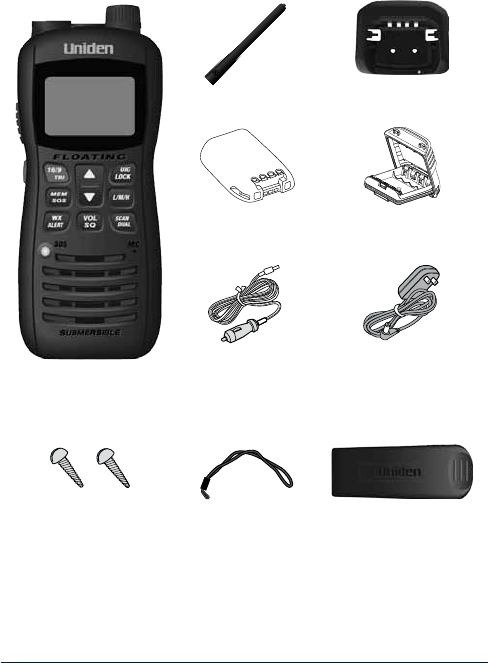
E-4 Uniden MHS126 Radio Owner’s Manual
Getting Started
What’s Included
Antenna Charging Cradle
Lithium Ion Poly
Battery
Alkaline Battery Tray
(batteries not included)
MHS126 Radio DC Charging
Adapter
AC-DC Charging
Adapter
Screws for Charging
Cradle
Wrist Strap Belt Clip
If any pieces are missing or damaged, contact Uniden
Customer Care (see back cover for contact information).
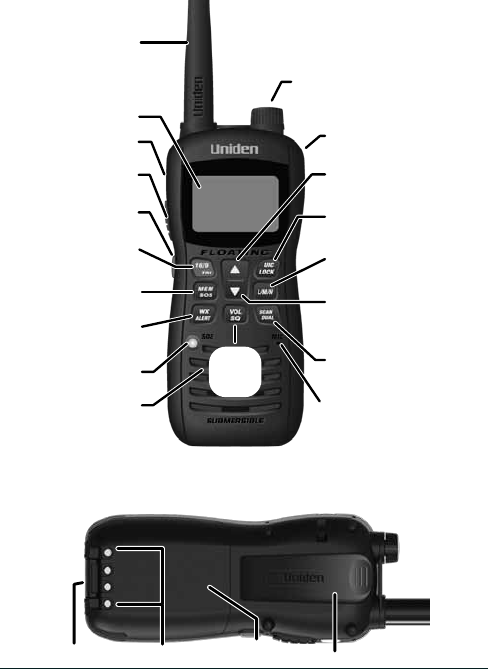
E-5
Uniden MHS126 Radio Owner’s Manual
Parts of the MHS126
Front view
Back view
Antenna
LCD display
L/M/H button
Channel up
button
External speaker and
microphone
Microphone
16/9-Tri
(16/9- triple
watch) button
WX-Alert
(weather-alert)
button Scan-Dual
(scan-dual
watch) button
Push to talk
button
Speaker
Wrist strap
anchor
Channel down
button
UIC/LOCK
button
Mem (memory)
SOS button
Strobe
SOS light
Power button
Boost
button
Volume/
Squelch
button
Belt clip
Battery
Battery charging
contacts
Battery
latch

E-6 Uniden MHS126 Radio Owner’s Manual
Button Press to... Press and hold to...
Power NA Turn the radio on or off.
PTT (Push
to Talk) NA Talk/transmit on a
channel.
Boost NA Transmit with a higher
power level.
16/9/TRI
1st press: Go to channel 16.
2nd press: Go to channel 9.
3rd press: Go back to the
starting channel.
Turn Triple Watch on
and off.
MEM/SOS
Save a channel into memory
or delete a channel from
memory.
Turn on the SOS signal.
Press and hold again to
turn on ashlight.
Press and hold again to
turn off the LED light.
WX/
ALERT
Places radio into Weather
mode so you can listen to
the weather channels.
Turn Weather Alert Watch
on and off.
Channel
Up
Move up one channel or
squelch/volume step at a
time.
Move quickly up the
channels/ squelch/volume
steps.
UIC/LOCK Switch from US to Canadian
or International channels.
Lock the keys; press and
hold again to unlock.
L/M/H Change the transmit power
(see page E-9). NA
Channel
Down
Move down one channel
or squelch/volume step at
a time.
Move quickly down the
channels/squelch/volume
steps.
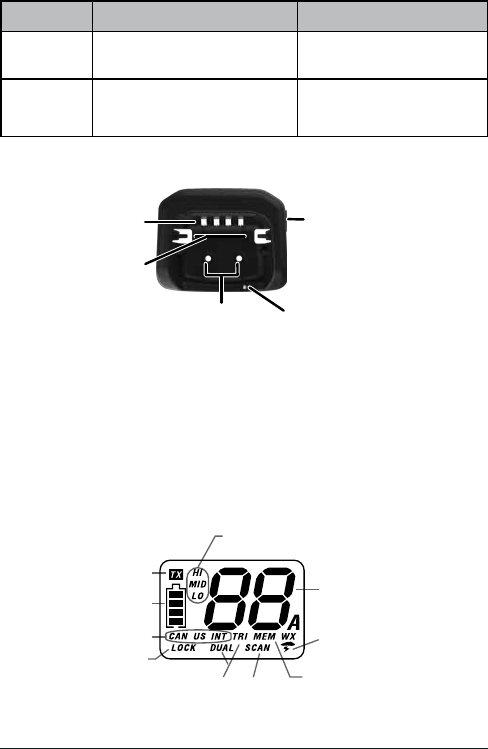
E-7
Uniden MHS126 Radio Owner’s Manual
Button Press to... Press and hold to...
SCAN/
DUAL
Start scanning channels
saved in memory.
Turn Dual Watch on and
off.
VOL/SQ Increase or decrease the
volume.
Increase or decrease the
squelch level.
Charger
Reading the Display
The LCD display shows different information depending on
what you are doing. This sample screen shows some of this
information. The following table shows all the possible icons
and what they mean.
Charging
contacts
CHARGE LEDScrew holes
for mounting
Power jack
[cigarette (DC) or
wall (AC) plug]
Charging
latches
Transmit
power level
This channel is
stored in memory.
Watch
mode The radio is in
scan mode
Key lock
is on
The radio is
transmitting Current
channel
number
UIC channel
mode
Weather
Alert Watch
is on.
Battery
status icon
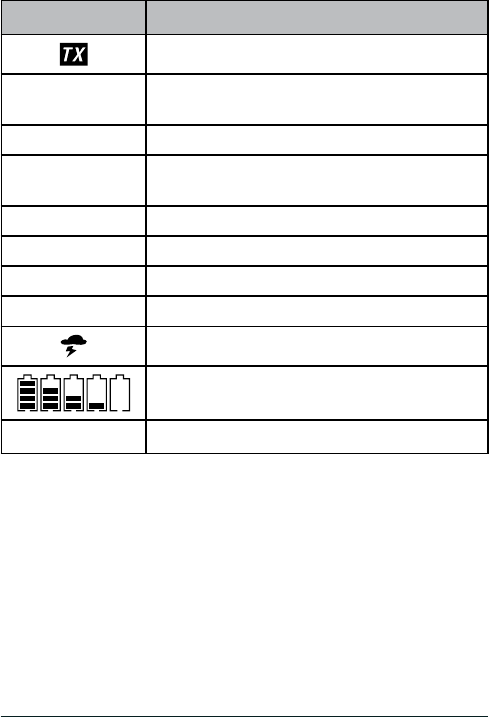
E-8 Uniden MHS126 Radio Owner’s Manual
Display icons and what they mean
Icon What it means
You are currently transmitting.
LO, MID, HI
The transmitter power is set to L (Low - 1W), M
(Mid - 2.5W), or H (HIGH - 6W).
LOCK
The keys are locked.
US, CAN, or INT
Indicates if the radio is set for US channels,
CANadian channels, or INTernational channels.
TRI or DUAL
TRIple Watch or DUAL Watch is turned on.
MEM
The current channel is saved in memory.
SCAN
The radio is in Scan mode.
WX
The radio is in Weather mode
Weather Alert Watch is turned on.
The battery is fully charged, mostly charged, half
charged, mostly empty, or completely empty.
88A Current channel number
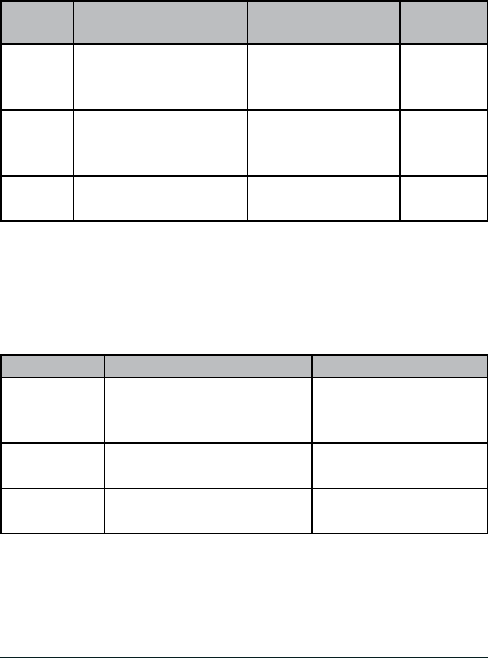
E-9
Uniden MHS126 Radio Owner’s Manual
How It Works
Your radio has three main operation modes: Normal, Scan,
and Weather.
Mode What it does Use it when you
want to...
To turn it
on/off
Normal
Monitors a single marine
channel and lets you talk
on that channel.
Monitor a channel or
talk to another radio.
(default
mode)
Scan Monitors all the channels
you save into memory.
Check a small group
of regularly-used
channels for trafc.
Press
SCAN/
DUAL.
Weather Monitors the selected
NOAA weather channel.
Hear the current or
forecasted weather.
Press WX/
ALERT.
In addition to the three operation modes, your radio provides
three different watch modes which you can activate during
any operation mode. In the watch modes, the radio briey
checks for activity on a specic channel, then returns to its
previous operation.
Watch mode What it does To turn it on/off
Weather Alert
Watch
Checks the last-used weather
channel for hazard alerts
every 7 seconds.
Press and hold WX/
ALERT for 2 seconds.
Dual Watch Checks channel 16 for activity
every 2 seconds.
Press and hold SCAN/
DUAL for 2 seconds.
Triple Watch Checks channels 16 and 9 for
activity every 2 seconds.
Press and hold 16/9/TRI
for 2 seconds.
#Private boats must monitor channel 16 whenever they are
underway. Water-going vessels should have either Triple
Watch or Dual Watch on at all times.
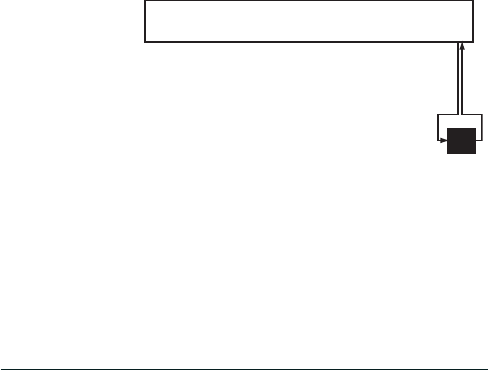
E-10 Uniden MHS126 Radio Owner’s Manual
Normal Mode Operation
To transmit, remove the radio from the charger, then press
and hold Push to Talk. Release the button when you are
nished talking.
For the best sound quality, hold the microphone about two
inches from your mouth while you’re talking.
Press Channel up to move up one channel at a time. Press
and hold the button to scroll quickly up the channels.
Press Channel down to move down one channel at a time.
Press and hold the button to scroll quickly down the
channels.
To change the transmit power, press L/M/H. The transmit
power switches to the next transmit power each time you
press this button.
Normal mode with Weather Alert Watch
If you activate
Weather Alert
Watch while
operating in
Normal mode,
the radio checks the most recently
used weather channel every few
seconds. If it detects a weather or
other hazard alert, it will switch to that
weather channel. (If you are actively
transmitting, the radio waits until you
nish your transmission before
checking the weather channel.)
wx
Every few seconds,
the radio checks
the last-used
weather channel.
WX Alert
Watch on
Monitoring Channel 25
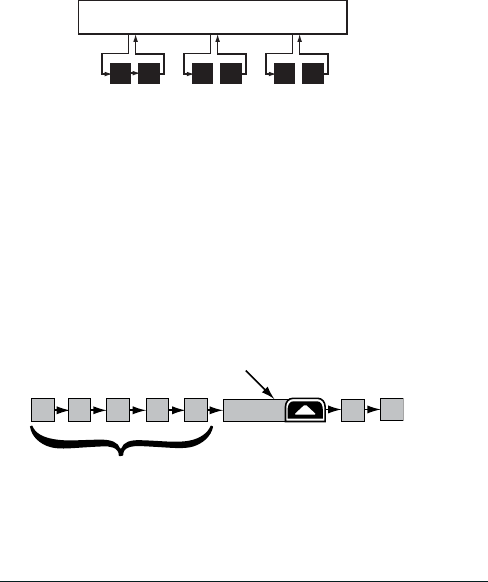
E-11
Uniden MHS126 Radio Owner’s Manual
Normal mode with Triple Watch or Dual Watch
If you activate Triple Watch while operating in Normal mode,
the radio checks channels 16 and 9 every two seconds; with
Dual Watch turned on, the radio only checks channel 16. The
radio will not check channels 16 or 9 while you are actively
transmitting; it waits until your transmission is nished and
then checks the channels.
Scan Mode Operation
You can save channels into memory and then use Scan
mode to monitor those channels from lowest to highest. If the
radio detects a signal on a channel, it stays on that channel
as long as the signal is received; when the signal stops, the
radio continues scanning.
09 16 09 16 09 16
Every 2 seconds, the radio
checks channels 9 & 16.
Triple Watch on
Monitoring Channel 25
11
1008 1312 14 17
15
The radio scans about
5 channels in 0.5 seconds.
When it detects a signal, the radio stays
on the channel until you press the
Channel Up button or the signal stops. Resume
scan
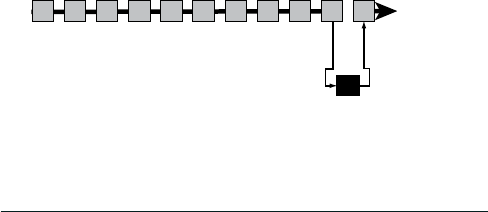
E-12 Uniden MHS126 Radio Owner’s Manual
Using the radio in Scan mode
To activate Scan mode, press SCAN/DUAL.
You must have at least two channels in memory to start
a scan. However, you cannot save marine channel 70 or
Weather channels.
You cannot transmit while in Scan mode.
To save a channel into memory, select the channel, then
press MEM/SOS. The MEM icon displays whenever you
tune to that channel.
To remove a channel from memory, set the radio to that
channel, then press MEM/SOS. The MEM icon no longer
displays.
When the radio stays on a channel, press Channel Up to
leave that channel and resume scanning.
To end the scan, press the SCAN/DUAL button again; the
radio remains on the last scanned channel.
Scan mode with Weather Alert Watch
If you activate Weather Alert Watch while in Scan mode, the
radio checks the most recently/used weather channel every
seven seconds, then continues scanning the next channel in
memory:
Every 7 seconds, the radio
checks the last-used
weather channel, then
scans the next channel. wx
WX Alert
Watch on
Memory Channel Scan
08 252417151413121110 20

E-13
Uniden MHS126 Radio Owner’s Manual
Scan mode with Triple Watch or Dual Watch
If you activate Triple Watch while operating in Scan mode,
the radio checks channels 16 and 9 every two seconds, then
goes on to scan the next channel; with Dual Watch turned
on, the radio only checks channel 16:
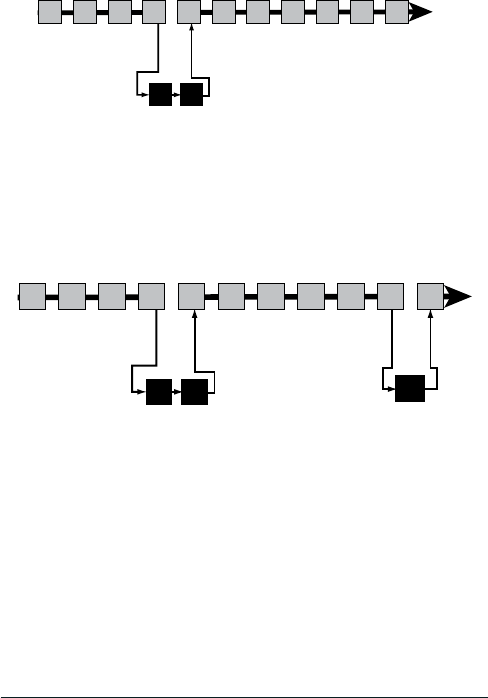
E-14 Uniden MHS126 Radio Owner’s Manual
Both Weather Alert and Triple/Dual Watch in Scan mode
You can activate Weather Alert Watch and Triple/Dual Watch
at the same time. The radio performs both checks at their
scheduled time:
Weather Mode
The NOAA weather channels cooperate with the FCC to
alert you of other hazards besides weather (child abduction
alerts, nuclear, biological, etc.). In Weather mode, the radio
monitors one of the nine NOAA weather channels. If any type
of alert is received, the radio sounds an alert tone and the
display blinks.
09 16
Every 2 seconds, the
radio checks channels
9 & 16, then scans
the next channel.
Triple
Watch on
Memory Channel Scan
08 252417151413121110 20
09 16
Every 2 seconds, the
radio checks channels
9 & 16, then scans
the next channel.
Triple
Watch on
Every 7 seconds, the radio
checks the last-used
weather channel, then
scans the next channel. wx
WX Alert
Watch on
Memory Channel Scan
08 252417151413121110 20

E-15
Uniden MHS126 Radio Owner’s Manual
Using the radio in weather mode
Press the WX/ALERT button to access Weather mode. WX
displays. Press to scroll through the weather channels.To
cancel Weather and return to the previous marine channel,
press the WX/ALERT button again. The last active weather
channel displays the next time you access Weather mode.
#You cannot transmit while in Weather mode.
When the radio detects a WX Alert signal, it sounds a siren
tone three times. Press any button to turn off the tone.
Weather mode with Weather Alert Watch
Because Weather mode already monitors the weather
channels, you don’t need Weather Alert Watch to check
the weather channel every seven seconds. If you activate
Weather Alert Watch while operating in Weather mode,
it operates as a type of “sleep mode;” the radio stays on
the weather channel and mutes the speaker. If an alert
is detected, the radio sounds an alert tone and turns the
speaker back on. This mode is very useful when you are
anchoring for the night but want to keep informed of hazards.
Weather mode with Triple Watch or Dual Watch
If you activate Triple
Watch while operating
in Weather mode, the
radio checks channels
16 and 9 every two
seconds; with Dual
Watch turned on, the
adio only checks channel 16.
09 16 09 16 09 16
Every 2 seconds, the radio checks
channel 9, then channel 16
with Triple Watch on
Monitoring Weather Channel WX08

E-16 Uniden MHS126 Radio Owner’s Manual
Setting Up the Hardware
Attaching the Antenna
The antenna detaches from the radio for
easy shipping or storage. To attach the
antenna to your radio, screw it tightly onto the
anchor post at the top of the radio.
Installing the Battery
Your radio comes with a rechargeable Li-Ion Polymer battery;
for shipping safety, the battery is not installed at the factory.
The empty alkaline battery tray is installed as a placeholder.
1) Insert the tabs on the battery into the notches at the top of
the battery compartment.
#Each time you remove the battery, check the rubber seal
around the battery compartment. Make sure the seal is
seated in the groove and there is no dirt or debris on it. If
the seal looks worn or damaged, contact customer service
to order a replacement (see back cover page for contact
information).
2) Lower the battery until it rests at in the compartment.
3) Bring the battery latch up and snap it into place.
Using the Alkaline Battery Tray
The radio also comes with an alkaline battery tray that holds
four AAA-type alkaline batteries (not included). You can use
alkaline batteries as a backup for the Li-Ion Polymer battery
so you can still use your radio while your Li-Ion Polymer
battery is recharging.
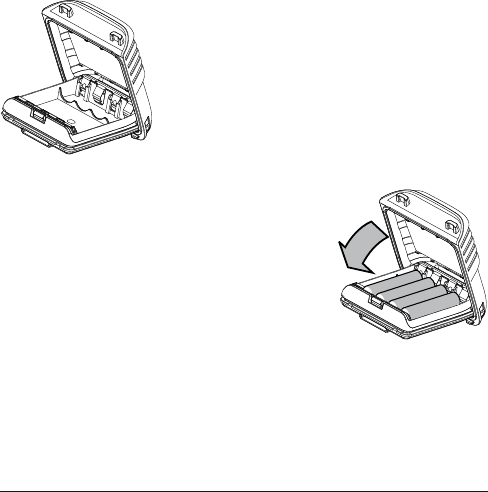
E-17
Uniden MHS126 Radio Owner’s Manual
CAUTION: If you are using your radio in a cold-weather
environment, Uniden recommends using non-
rechargeable Lithium batteries.
#When using alkaline batteries, transmit power is limited to
a maximum of 2.5W.
Follow these steps to use the alkaline battery tray:
1) Hold the lower part of the tray in one hand with the three
battery contacts facing down. Use your thumb to hold the
notch on the lower part of the tray.
2) With your other hand, grip the
upper part of the tray and lift the
cover open.
3) Align the batteries’ positive and
negative terminals with the drawing
on the tray and snap each battery
into place.
4) Insert the two hooks on the lower
part
of the tray into the notches on the
cover; close the cover. (The cover ts
snugly but you should not have to
force it closed.)
5) Install the alkaline battery tray in
your radio just as you do the Li-Ion
Polymer battery (see page E-15).
WARNING! The tray is designed to prevent the
accidental charging of alkaline batteries. Never
use alkaline batteries in the radio without the
alkaline battery tray. Do not attempt to modify the
battery tray design.
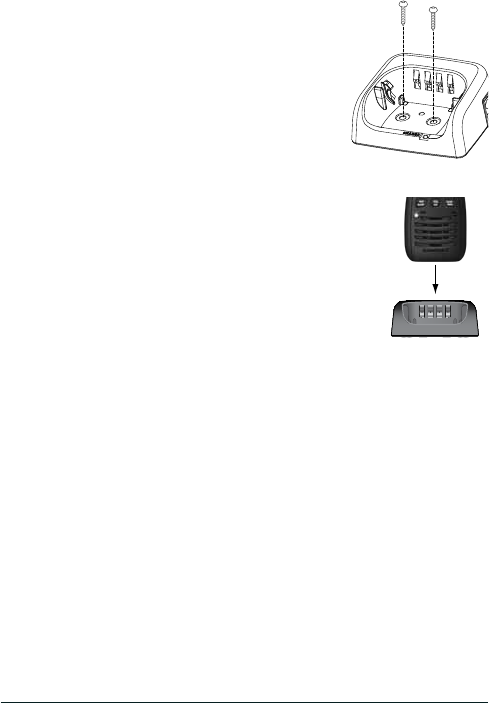
E-18 Uniden MHS126 Radio Owner’s Manual
Mounting the Charger
You can mount the charger on any at surface.
1) Use the two holes at the base of the
charger as a template to mark the drill
holes.
2) Using a 1/8-inch (or 3 mm) drill bit, drill
two holes 1/2 inch (13mm) deep.
3) Use the provided screws to attach the
charger to the surface.
Charging the Battery
Your radio includes a charger and a
rechargeable battery pack. Place your radio in
the charger with the display facing forward.
Make sure that the CHARGE LED on the
charger turns orange.
Cautions:
Use only the battery and charger supplied with this radio.
Using a different charger or battery can damage the radio
and create a risk of re or shock.
The charger is not waterproof. If the charger falls into the
water, unplug it before attempting to remove it from the
water. After you remove the charger from the water, please
contact our Customer Care Line.
Wipe off dirt or shake water from your radio before placing
in the charger if your radio gets dirty or wet.
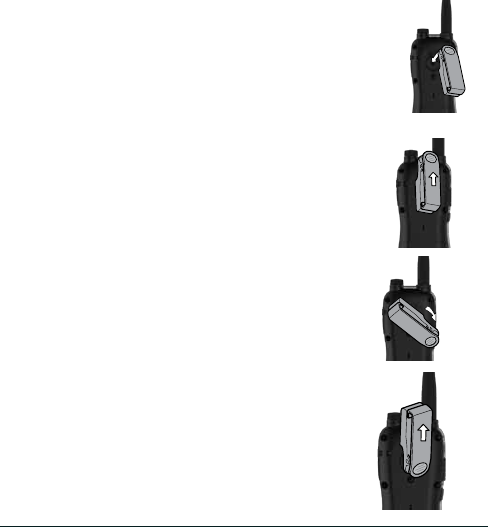
E-19
Uniden MHS126 Radio Owner’s Manual
Important notes on charging the battery
Charge the battery fully before using the radio. When the
battery is completely charged, the CHARGE LED turns
green.
Don’t use the charger when the ambient temperature is
below 0° C (32° F) or above 45° C (113° F).
If the radio is powered down, the battery can charge in
about seven hours. (If the radio is powered on, the battery
takes longer to charge.)
Attaching the Belt Clip
To attach the belt clip:
1) Rotate the belt clip so that the nger
indentation is towards the top of the
radio.
2) Align the center of the clip with the anchor
post.
3) Place the clip on the post and slide the
clip upwards until it clicks into place.
To remove the belt clip:
1) Rotate the clip so that the nger
indentation is towards the bottom
of the radio.
2) Slide the clip up until it comes free
of the anchor post.
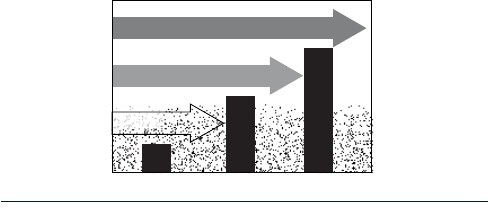
E-20 Uniden MHS126 Radio Owner’s Manual
Using Your Radio
Turning It On
Press and hold POWER for at least two seconds to turn the
radio on. Press and hold POWER again to turn the unit off.
Setting It Up
Even though you can change your radio’s settings at any
time, you will probably want to establish initial settings after
you have turned it on for the rst time. You will adjust some
of these settings on an as-needed basis, but some settings
might only need to be set once.
Changing the volume
To change the speaker volume, press VOL/SQ to enter
Volume Setting mode. O (for volume level 0 - 9) displays.
Press CHANNEL UP or CHANNEL DOWN to increase or
decrease the volume levels. Press VOL/SQ to save.
Setting the Squelch level
The MHS126 recognizes signals as transmissions if they
exceed a signal strength threshold.
Weak signals
No
Squelch
Medium
Squelch
High
Squelch
Strong signals
Noise
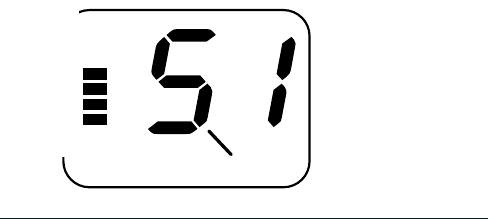
E-21
Uniden MHS126 Radio Owner’s Manual
Adjusting the squelch sets this threshold level. Increasing
squelch requires a signal to be stronger to be seen as a
transmission. If you set the squelch too high, you will risk not
receiving transmissions that are lower than that threshold.
Reducing the squelch allows weaker signals to be accepted.
However, if you lower the squelch too much, you will hear
white noise all the time
While listening to a channel, press and hold VOL/SQ to enter
Squelch Setting mode.The
SQUELCH Level
(S0)number
displays on the LCD. Press CHANNEL UP or CHANNEL DOWN to
increase or decrease the squelch levels (0 - 3). Press VOL/SQ
to save the setting.
#Note: Setting the squelch level too high may prevent
you from hearing weaker transmissions. If you are having
difculty hearing a transmission, try setting the squelch
level lower.
Reading volume and squelch level on battery icon
When you adjust the volume or squelch levels, the 4 bars on
the battery icon display according to the volume and squelch
levels. For example, two bars display for VOL levels 3 and 4,
and Squelch level 2.
.
7 - 9
5 - 6
3 - 4
1 - 2
VOL
Level
(0 - 9)
SQ Level
(0 - 3)
3
2
1
0
No bars Squelch

E-22 Uniden MHS126 Radio Owner’s Manual
Setting the UIC channel mode (USA/CAN/INT)
You can select marine channels for the USA, Canada, or
International waters. Press UIC/LOCK to scroll through USA,
CANada, or INTernational channel options.
Using the WX Mode
Press WX/ALERT to switch to WX mode; you can then listen
to one of the 9 weather channels. Press and hold WX/ALERT
to turn on Weather Alert mode. The radio then monitors the
current weather channel and alerts you to any broadcast
weather alerts or notications. The icon displays to
indicate that WX Alert is on.
Making a Transmission
Selecting a channel
Press Channel Up and Channel Down briey to scroll through
the channels one channel at a time. Press and hold Channel
Up or Channel Down to quickly scroll through the channels.
Making a transmission
Press and hold Push to Talk.
TX
displays while you are
transmitting. Release Push to Talk when you’re nished talking
to let the other party respond.
To prevent stuck microphone problems or situations where
Push to Talk is pushed accidentally, the radio limits your
talk time to 5 minutes in a single transmission.
For the best sound quality, hold the microphone about two
inches away from your mouth.

E-23
Uniden MHS126 Radio Owner’s Manual
Some marine channels and Weather mode channels are
Receive Only. See page E-27 for a list of receive-only
channels.
#There is a 5 minute limit for continuous transmission.
After 5 minutes the unit goes into a PTT error condition;
the timeout tone sounds, TX displays, and the channel
indicators blink.
Boosting the transmission power
In most situations, 1W transmission power is all you need.
If you nd yourself far away from other stations and have
trouble getting a response, you may need to boost the
transmission power from 1W to 2.5W or 6W.
#Alkaline battery boost is limited to 2.5W
#Channels 75 and 76 are 1W only and do not have power
override capability.
1) Select the channel you want to transmit on.
2) Press L/M/H to switch to the next transmission power level
(for example, from 1W to 2.5W; from 2.5W to 6W, or from
6W back to 1W).
3) The display shows the new transmission power. The
transmit power remains at the new setting until you
change it again.
#Don’t forget to change the transmission setting back to
1W when you move close to other stations.
Some channels (for example, channels 13 and 67) limit
the transmission power to 1W. When you tune to a limited-
power channel, the radio automatically switches to 1W.
See page E-27 for a list of power-restricted channels.

E-24 Uniden MHS126 Radio Owner’s Manual
Saving Channels to Memory
If you nd a channel you like and want to listen to it again,
save it to memory. Press MEM/SOS; the active channel is
stored in memory and
MEM
displays. Press SCAN DUAL to
scan the channels in memory.
#You must have at least 2 channels in memory in order to
use Scan mode. Channel 70 and WX channels cannot be
stored into memory.
Press SCAN/DUAL again to remove the channel from memory.
Special Features
Using the Strobe SOS Light/Flashlight
You can use this radio in an emergency. If you turn on the
strobe SOS high-intensity LED light on your radio, your radio
will blink “S O S” in international Morse Code. This will make
it easier for rescuers to nd you faster.
#Your radio operates normally when the SOS LED strobe is
activated.
With the SOS LED
in this state - Do This - For this -
OFF Press and hold Mem/
SOS for 2 seconds.
SOS LED signals SOS
in Morse code.
SOS Press and hold Mem/
SOS for 2 seconds.
SOS LED remains
on continuously.
(Flashlight mode)
Continuous Press and hold Mem/
SOS for 2 seconds. SOS LED turns off.

E-25
Uniden MHS126 Radio Owner’s Manual
Turning the key beep on and off
Key beep is the tone that sounds when you press a key or a
button. You cannot change the key beep volume.
To turn key beep on or off, press and hold Channel up or
Channel down while turning on the radio. You may need to turn
off the radio rst.
Setting Key Lock
You can lock and unlock the keypad by pressing and holding
UIC/LOCK. If Key Lock is on, only PTT, Boost, and power on/
off will operate. Key Lock remains in memory when the radio
is turned off.
Key Lock will automatically turn off if a WX Alert signal is
received.
Using the external speaker/Mic jack
You can connect an optional external speaker-mic to this
watertight jack. Unscrew the cap, which is held by the rubber
cap-keeper to prevent loss. Insert the special gasketed
plug and screw down the shell, which prevents water from
entering the jack.
For details, consult your dealer or contact Uniden Customer
Care directly (see back cover for contact information).
Using the Battery Save feature
The Battery Save feature automatically turns off receive
power at regular intervals to save battery power. Battery
Save turns of when receiving transmissions or transmitting
a response. It reactivates after 3 seconds of no activity
(transmit or receive).

E-26 Uniden MHS126 Radio Owner’s Manual
#Battery Save does not work while in Scan mode or in
Triple/Dual watch, and while WX alert is active.
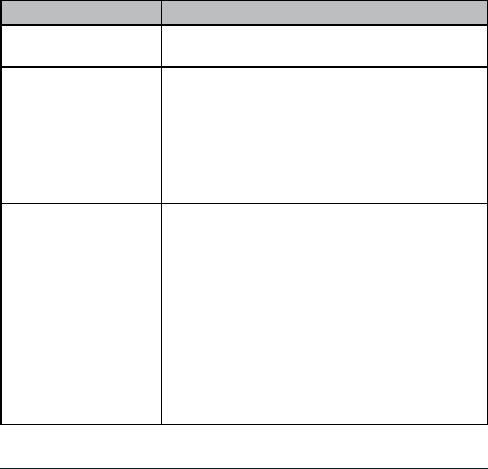
E-27
Uniden MHS126 Radio Owner’s Manual
Maintenance and Troubleshooting
Due to its rugged design, your radio requires very little
maintenance. However, it is a precision electronic instrument,
so you should follow a few precautions:
If the antenna has been damaged, do not transmit except
in an emergency situation. Transmitting with a defective
antenna may cause further radio damage.
You are responsible for continued FCC technical
compliance of your radio.
Common Questions
Problem Things to Try
The radio won’t turn
on. Charge the radio.
The power LED on
the charger doesn’t
turn on.
– Don’t use the charger when the ambient
temperature is below 0° C (32° F) or above
45° C (113° F).
– Make sure the charging contacts on the
radio and charger are clean.
– Replace the battery.
The radio won’t
transmit.
Make sure you are not in Weather or Scan
mode.
Make sure you are not trying to transmit on a
receive-only channel or transmit at the wrong
power level for this channel (see the channel
lists starting on page E-27).
Check the battery power level; if it’s low, charge
the battery before trying to transmit.
Make sure the duration of each transmission is
less than 5 minutes.
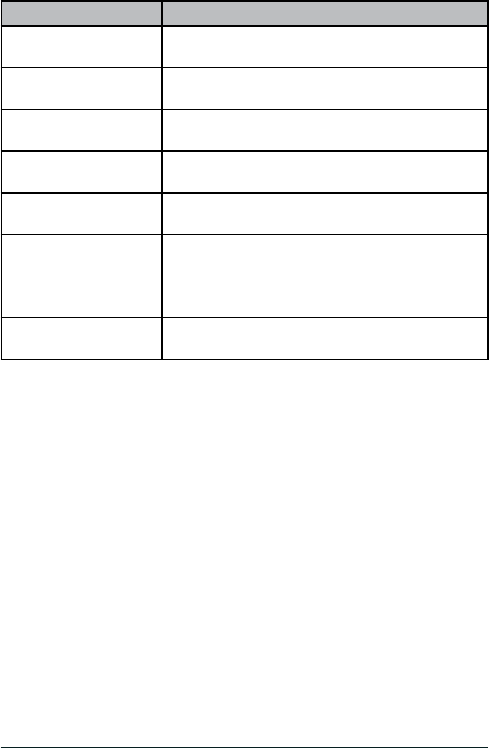
E-28 Uniden MHS126 Radio Owner’s Manual
Problem Things to Try
I can’t hear anything
from the speaker. Adjust the squelch level; it is probably too high.
The sound is mufed
or the volume is low. Clear water from the speaker grill.
Noise comes out of the
speaker all the time. Adjust the squelch level; it is probably too low.
I can transmit, but no
one can hear me.
Check your UIC channel settings: does the area
you are in use different channel assignments?
I’m not getting hazard
alerts. Make sure Weather Alert Watch is turned on.
The display ashes,
and I don’t know why.
The channel number on the display will ash if
the radio is in a Watch mode or in Scan mode.
Try turning off scanning, Weather Alert Watch,
Triple Watch, or Dual Watch (see page E-8).
Where can I nd my
radio’s serial number?
The serial number is on a plate inside the battery
compartment.
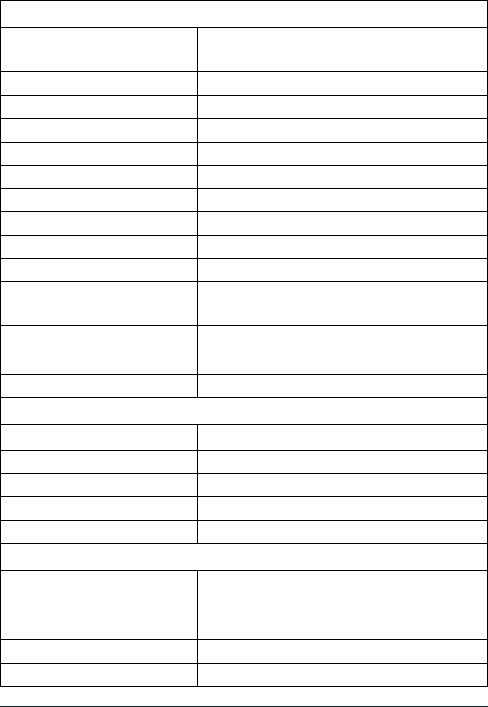
E-29
Uniden MHS126 Radio Owner’s Manual
Specications
General
Channels All US/International/Canada marine
channels
9 Weather channels
Freq. Control PLL
Freq. Tol. Transmit: 0.5 PPM (at 25°C) nominal
Receive: 0.5 PPM (at 25°C) nominal
Oper. Temp. -4°F (-20°C) to +122°F(+50°C)
Antenna Flexible Whip
Microphone Built-in Electret type
Display Liquid Crystal Display
Speaker 8Ω 1.0 Watt
Power Source Rechargeable Lithium Ion Battery
7.4V 1160 mAh
Size (without antenna) 5.95 (H) x 2.40 (W) x 1.69 (D) inch
142 (H) x 61 (W) x 43 (D) mm
Weight 9.9 oz (281g) (w/battery and antenna)
Transmitter
Frequency Range 156~158 MHz
Frequency Stability ±3 PPM (nominal)
Power Output 1.0 W & 2.5W & 6W
Spurious Emissions 70 dBm
Current Drain 1400 mA (6W) nominal
Receiver
Type
Double Conversion Super Heterodyne
Phase Locked Loop system for Local
Oscillator
Frequency Range 156~164 MHz
Sensitivity 0.22 μV for 12dB SINAD (nominal)

E-30 Uniden MHS126 Radio Owner’s Manual
Squelch Sensitivity Threshold 0.18 μV (nominal)
Audio Frequency Response +5.0 dB @ 500 Hz; -6 dB @ 2000Hz
(nominal)
Adjacent Channel Selectivity 80 dB @ ±25 kHz (nominal)
Audio Output Power 1.0 W @10% THD (nominal)
Current Drain Squelched: 38 mA; Max. Audio: 230 mA
(nominal)
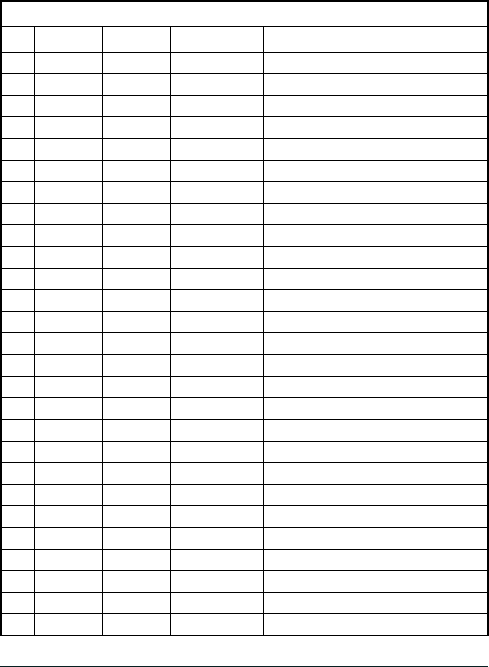
E-31
Uniden MHS126 Radio Owner’s Manual
Channels and Frequencies (MHz)
US Channel Frequencies and Names
US Marine Channels
Ch RX Freq TX Freq Status Name
1A 156.050 156.050 Simplex Vessel trafc system/commercial
5A 156.250 156.250 Simplex Vessel trafc system/commercial
6 156.300 156.300 Simplex Inter-ship safety
7A 156.350 156.350 Simplex Commercial
8 156.400 156.400 Simplex Commercial
9 156.450 156.450 Simplex Non commercial
10 156.500 156.500 Simplex Commercial
11 156.550 156.550 Simplex Vessel trafc system
12 156.600 156.600 Simplex Vessel trafc system
13 156.650 156.650 Simplex, 1W Bridge to bridge
14 156.700 156.700 Simplex Vessel trafc system
15 156.750 Inhibit Receive only Environmental
16 156.800 156.800 Simplex Distress, safety, and calling
17 156.850 156.850 Simplex, 1W Govt maritime control
18A 156.900 156.900 Simplex Commercial
19A 156.950 156.950 Simplex Commercial
20 161.600 157.000 Duplex Port operation
20A 157.000 157.000 Simplex Port operation
21A 157.050 157.050 Simplex Coast guard only
22A 157.100 157.100 Simplex Coast guard
23A 157.150 157.150 Simplex Coast guard only
24 161.800 157.200 Duplex Marine operator
25 161.850 157.250 Duplex Marine operator
26 161.900 157.300 Duplex Marine operator
27 161.950 157.350 Duplex Marine operator
28 162.000 157.400 Duplex Marine operator
63A 156.175 156.175 Simplex Vessel trafc system
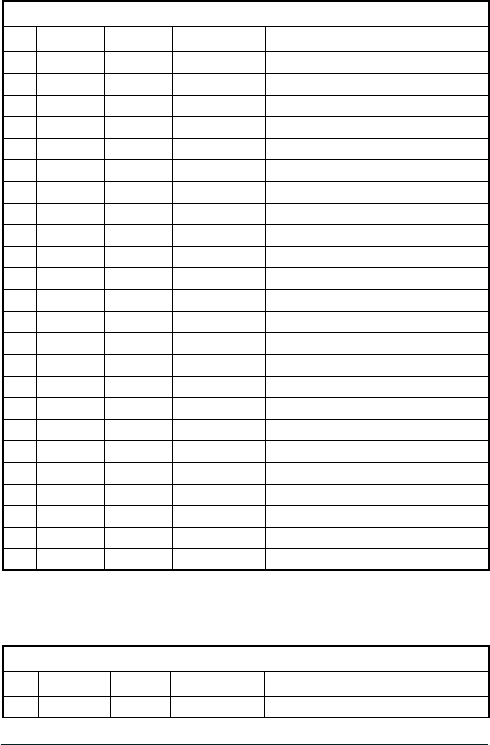
E-32 Uniden MHS126 Radio Owner’s Manual
US Marine Channels
Ch RX Freq TX Freq Status Name
65A 156.275 156.275 Simplex Port operation
66A 156.325 156.325 Simplex Port operation
67 156.375 156.375 Simplex, 1W Bridge To Bridge
68 156.425 156.425 Simplex Non Commercial
69 156.475 156.475 Simplex Non Commercial
70 156.525 Inhibit Receive only Digital Selective Calling
71 156.575 156.575 Simplex Non Commercial
72 156.625 156.625 Simplex Non Commercial (Ship-Ship)
73 156.675 156.675 Simplex Port Operation
74 156.725 156.725 Simplex Port Operation
75 156.775 156.775 Simplex, 1W Port Operation
76 156.825 156.825 Simplex, 1W Port Operation
77 156.875 156.875 Simplex, 1W Port Operation (Ship-Ship)
78A 156.925 156.925 Simplex Non Commercial
79A 156.975 156.975 Simplex Commercial
80A 157.025 157.025 Simplex Commercial
81A 157.075 157.075 Simplex Coast Guard
82A 157.125 157.125 Simplex Coast Guard
83A 157.175 157.175 Simplex Government
84 161.825 157.225 Duplex Marine Operator
85 161.875 157.275 Duplex Marine Operator
86 161.925 157.325 Duplex Marine Operator
87 157.375 157.375 Simplex Marine Operator
88 157.425 157.425 Simplex Commercial (Ship-Ship)
Canadian Channel Frequencies and Names
Canadian Marine Channels
Ch RX Freq TX Freq Status Name
1 160.650 156.050 Duplex Marine Operator
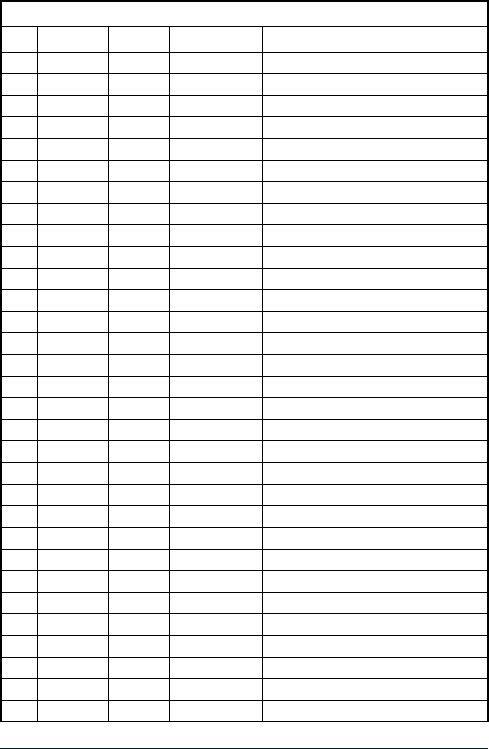
E-33
Uniden MHS126 Radio Owner’s Manual
Canadian Marine Channels
Ch RX Freq TX Freq Status Name
2 160.700 156.100 Duplex Marine Operator
3 160.750 156.150 Duplex Marine Operator
4A 156.200 156.200 Simplex Canadian Coast Guard
5A 156.250 156.250 Simplex Vessel Trafc System
6 156.300 156.300 Simplex Inter-Ship Safety
7A 156.350 156.350 Simplex Commercial
8 156.400 156.400 Simplex Commercial
9 156.450 156.450 Simplex Boater Calling Channel
10 156.500 156.500 Simplex Commercial
11 156.550 156.550 Simplex Vessel Trafc System
12 156.600 156.600 Simplex Vessel Trafc System
13 156.650 156.650 Simplex, 1W Bridge To Bridge
14 156.700 156.700 Simplex Vessel Trafc System
15 156.750 156.750 Simplex, 1W Environmental
16 156.800 156.800 Simplex Distress, safety, calling
17 156.850 156.850 Simplex, 1W State Control
18A 156.900 156.900 Simplex Commercial
19A 156.950 156.950 Simplex Canadian Coast Guard
20 161.600 157.000 Duplex, 1W Port Operation
21A 157.050 157.050 Simplex Canadian Coast Guard
22A 157.100 157.100 Simplex Canadian Coast Guard
23 161.750 157.150 Duplex Canadian Coast Guard
24 161.800 157.200 Duplex Marine Operator
25 161.850 157.250 Duplex Marine Operator
26 161.900 157.300 Duplex Marine Operator
27 161.950 157.350 Duplex Marine Operator
28 162.000 157.400 Duplex Marine Operator
60 160.625 156.025 Duplex Marine Operator
61A 156.075 156.075 Simplex Canadian Coast Guard
62A 156.125 156.125 Simplex Canadian Coast Guard
63A 156.175 156.175 Simplex Port Operation
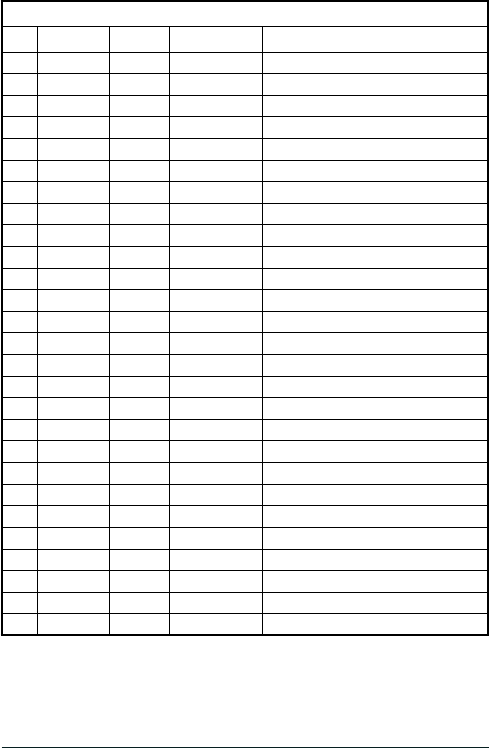
E-34 Uniden MHS126 Radio Owner’s Manual
Canadian Marine Channels
Ch RX Freq TX Freq Status Name
64 160.825 156.225 Duplex Marine Operator
64A 156.225 156.225 Simplex Port Operation
65A 156.275 156.275 Simplex Port Operation
66A 156.325 156.325 Simplex, 1W Port Operation
67 156.375 156.375 Simplex Bridge To Bridge
68 156.425 156.425 Simplex Non Commercial
69 156.475 156.475 Simplex Non Commercial
70 156.525 Inhibit Receive only Digital Selective Calling
71 156.575 156.575 Simplex Non Commercial
72 156.625 156.625 Simplex Non Commercial
73 156.675 156.675 Simplex Port Operation
74 156.725 156.725 Simplex Port Operation
75 156.775 156.775 Simplex, 1W Port Operation
76 156.825 156.825 Simplex, 1W Port Operation
77 156.875 156.875 Simplex, 1W Port Operation
78A 156.925 156.925 Simplex Inter Ship
79A 156.975 156.975 Simplex Inter Ship
80A 157.025 157.025 Simplex Inter Ship
81A 157.075 157.075 Simplex Canadian Coast Guard
82A 157.125 157.125 Simplex Canadian Coast Guard
83 161.775 157.175 Duplex Canadian Coast Guard
83A 157.175 157.175 Simplex Canadian Coast Guard
84 161.825 157.225 Duplex Marine Operator
85 161.875 157.275 Duplex Marine Operator
86 161.925 157.325 Duplex Marine Operator
87 157.375 157.375 Simplex Port Operation
88 157.425 157.425 Simplex Port Operation
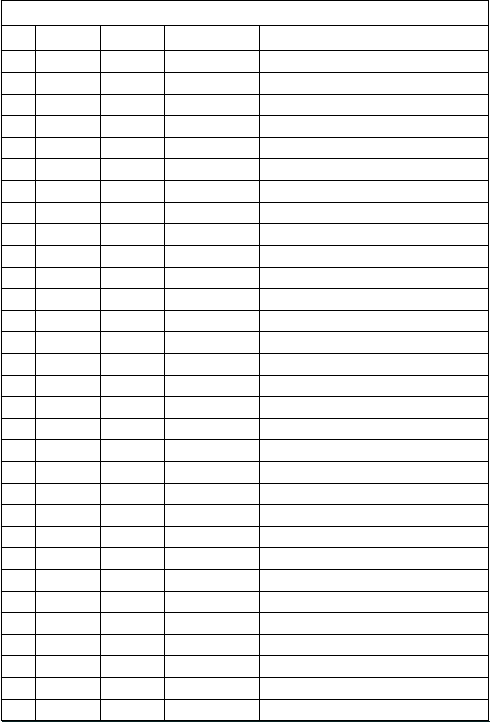
E-35
Uniden MHS126 Radio Owner’s Manual
International Channel Frequencies and Names
International Marine Channels
Ch RX Freq TX Freq Status Name
1 160.650 156.050 Duplex Marine operator
2 160.700 156.100 Duplex Marine operator
3 160.750 156.150 Duplex Marine operator
4 160.800 156.200 Duplex Marine operator
5 160.850 156.250 Duplex Marine operator
6 156.300 156.300 Simplex Inter-ship safety
7 160.950 156.350 Duplex Marine operator
8 156.400 156.400 Simplex Commercial (ship-ship)
9 156.450 156.450 Simplex Boater calling channel
10 156.500 156.500 Simplex Commercial
11 156.550 156.550 Simplex Vessel trafc system
12 156.600 156.600 Simplex Vessel trafc system
13 156.650 156.650 Simplex Bridge to bridge
14 156.700 156.700 Simplex Vessel trafc system
15 156.750 156.750 Simplex, 1W Environmental
16 156.800 156.800 Simplex Distress, safety, calling
17 156.850 156.850 Simplex, 1W Govt maritime control
18 161.500 156.900 Duplex Port operation
19 161.550 156.950 Duplex Commercial
20 161.600 157.000 Duplex Port operation
21 161.650 157.050 Duplex Port operation
22 161.700 157.100 Duplex Port operation
23 161.750 157.150 Duplex Marine operator
24 161.800 157.200 Duplex Marine operator
25 161.850 157.250 Duplex Marine operator
26 161.900 157.300 Duplex Marine operator
27 161.950 157.350 Duplex Marine operator
28 162.000 157.400 Duplex Marine operator
60 160.625 156.025 Duplex Marine operator
61 160.675 156.075 Duplex Marine operator
62 160.725 156.125 Duplex Marine operator
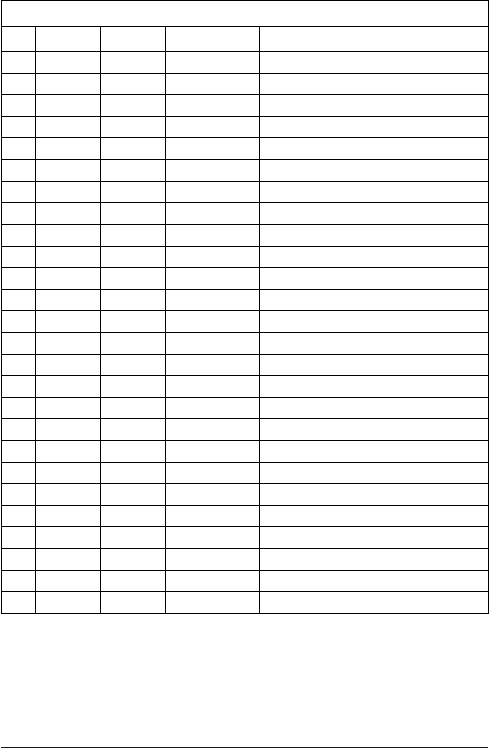
E-36 Uniden MHS126 Radio Owner’s Manual
International Marine Channels
Ch RX Freq TX Freq Status Name
63 160.775 156.175 Duplex Marine operator
64 160.825 156.225 Duplex Marine operator
65 160.875 156.275 Duplex Marine operator
66 160.925 156.325 Duplex Marine operator
67 156.375 156.375 Simplex Bridge to bridge
68 156.425 156.425 Simplex Non commercial
69 156.475 156.475 Simplex Non commercial
70 156.525 Inhibit Receive only Digital Selective Calling
71 156.575 156.575 Simplex Non commercial
72 156.625 156.625 Simplex Non commercial
73 156.675 156.675 Simplex Port operation
74 156.725 156.725 Simplex Port operation
75 156.775 156.775 Simplex, 1W Port operation
76 156.825 156.825 Simplex, 1W Port operation
77 156.875 156.875 Simplex Port operation (ship-ship)
78 161.525 156.925 Duplex Port operation
79 161.575 156.975 Duplex Port operation
80 161.625 157.025 Duplex Port operation
81 161.675 157.075 Duplex Port operation
82 161.725 157.125 Duplex Port operation
83 161.775 157.175 Duplex Port operation
84 161.825 157.225 Duplex Marine operator
85 161.875 157.275 Duplex Marine operator
86 161.925 157.325 Duplex Marine operator
87 157.375 157.375 Simplex Marine operator
88 157.425 157.425 Simplex Marine operator

E-37
Uniden MHS126 Radio Owner’s Manual
Weather Channel Frequencies and Names
Channel RX Channel RX
WX01 162.5500 WX06 162.5000
WX02 162.4000 WX07 162.5250
WX03 162.4750 WX08 161.6500
WX04 162.4250 WX09 161.7750
WX05 162.4500

E-38 Uniden MHS126 Radio Owner’s Manual
Regulations and Safety Warnings
Maritime Radio Services Operation
Warning! This transmitter will operate on channels/frequencies that have
restricted use in the United States. The channel assignments include
frequencies assigned for exclusive use of the U.S. Coast Guard, use in
Canada, and use in international waters. Operation on these frequencies
without proper authorization is strictly forbidden. See page E-31 for tables of
the available channels and their uses. If you are still not certain which
channels to use, see the FCC maritime radio page at the FCC website
(
http://wireless.fcc.gov/marine/
) or contact the FCC Call Center at
1-888-CALL-FCC. For individuals requiring a license, such as commercial
users, you should obtain a license application from your nearest FCC eld
ofce (for US users) or Industry Canada (for Canadian users).
Basic Radio Guidelines
You should familiarize yourself with the rules on marine radios and be
aware of which rules apply to your boat. Complete guidelines for all ship
and marine radio types can be found at the US Coast Guard website
under the topic Radio Info for Boaters (the direct link is
http://www.navcen.uscg.gov/marcomms/boater.htm
). Here are a few
guidelines that affect nearly all boaters.
If you have a VHF radio on your boat, you must maintain a watch on
channel 16 (156.800 MHz) whenever the radio is not being used to
communicate. Starting in 2004, if a radio is carried, it must be on and set
to channel 16. Whenever your boat is underway.
If you hear a distress call, wait a few minutes to let a shore station or
Coast Guard vessel respond. If no other station has responded after 5
minutes, you must respond to the distress call.
WARNING! Read this information before
using the radio.

E-39
Uniden MHS126 Radio Owner’s Manual
Do not make false mayday or distress calls as a prank or to test your
radio. (This is essentially like making a false 9-1-1 call; you may be subject
to nes.)
Certication: FCC Part 80 or RSS-182
Output Power: 6W
Emission: 16K0F3E
Transmitter Frequency Range: 156.025-157.425 MHz
This device complies with Part 15 of the FCC Rules. Operation is subject
to the condition that this device does not cause harmful interference.
Unauthorized changes or modications to this equipment may void
compliance with the FCC Rules. Any change or modication must be
approved in writing by Uniden. Changes or modications not approved by
Uniden could void the user’s authority to operate the equipment.
In August 1996 the Federal Communications Commission (FCC) of the
United States with its action in Report and Order FCC 96-326 adopted
an updated safety standard for human exposure to radio frequency
electromagnetic energy emitted by FCC regulated transmitters. Those
guidelines are consistent with the safety standard previously set by both
U.S. and international standards bodies. The design of the radio complies
with the FCC guidelines and these international standards.
Never allow children to operate the radio without adult supervision and the
knowledge of the following guidelines.
WARNING! It is up to the user to properly operate this radio transmitter to
insure safe operation. Please adhere to the following:
Use only the supplied or an approved antenna. Unauthorized antennas,
modications, or attachments could impair call quality, damage the radio,
or violate FCC regulations.

E-40 Uniden MHS126 Radio Owner’s Manual
Do not use the radio with a damaged antenna. If a damaged antenna
comes into contact with the skin, a minor burn may result. Please contact
your local dealer for a replacement antenna.
To maintain compliance with FCC RF exposure requirements, the radio
must be used with a maximum duty cycle not exceeding 50% in a typical
push-to-talk radio use time. DO NOT transmit for more than 50% of total
radio use time.
This device was tested for typical body-worn operations using the supplied
belt-clip. To maintain compliance with FCC RF exposure requirements,
body-worn operations are restricted to the supplied belt-clip. For hand-
held operation, the radio should be held 1 inch from the user’s face. The
use of accessories that do not satisfy these requirements may not comply
with FCC RF exposure requirements and should be avoided. For more
information about RF exposure, please visit the FCC website at www.fcc.
gov.
This equipment contains a rechargeable Lithium-Ion Polymer battery. The
rechargeable Lithium-Ion Polymer battery contained in this equipment may
explode if disposed of in a re.
Do not short-circuit the battery.
Do not charge the rechargeable battery used in this equipment in any
charger other than the one specied in the owner’s manual. Using another
charger may damage the battery or cause the battery to explode.
NOTE: Li-Ion Polymer batteries must be recycled or disposed of
properly.
Avoid exposing the battery (whether attached to the radio or not) to direct
sunlight, heated cars, or temperatures below -4°F (-20°C) or above
+140°F (+60°C). Exposing the chemical contained within the battery pack
to temperatures above +140°F (+60°C) may cause the battery to rupture,
fail, or reduce performance.
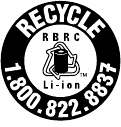
In case of exposure to the cell contents, wash the affected area thoroughly,
and seek medical attention.
As part of our commitment to protect the environment
and conserve natural resources, Uniden voluntarily
participates in an RBRC® industry program to collect
and recycle used Li-Ion Polymer batteries within the US.
Please call 1-800-8-BATTERY for information on Li-
Ion Polymer battery recycling in your area.
(RBRC® is a registered trademark of the Rechargeable Battery
Recycling Corporation.)
WARRANTOR: UNIDEN AMERICA CORP. (“Uniden”)
ELEMENTS OF WARRANTY: Uniden warrants, for three years, to the
original retail owner, this Uniden Product to be free from defects in
materials and craftsmanship with only the limitations or exclusions set out
below.
WARRANTY DURATION: This warranty to the original user shall terminate
and be of no further effect 36 months after the date of original retail sale.
The warranty is invalid if the Product is (A) damaged or not maintained
as reasonable or necessary, (B) modied, altered, or used as part of any
conversion kits, subassemblies, or any congurations not sold by Uniden,
(C) improperly installed, (D) serviced or repaired by someone other than
an authorized Uniden service center for a defect or malfunction covered
by this warranty, (E) used in any conjunction with equipment or parts or
as part of any system not manufactured by Uniden, or (F) installed or
programmed by anyone other than as detailed by the Operating Guide for
this product.
STATEMENT OF REMEDY: In the event that the product does not
conform to this warranty at any time while this war-ranty is in effect,
warrantor will repair the defect and return it to you without charge for
parts, service, or any other cost (except shipping and handling) incurred
by warrantor or its representatives in connection with the performance of
this warranty. THE LIMITED WARRANTY SET FORTH ABOVE IS THE
SOLE AND ENTIRE WARRANTY PERTAINING TO THE PRODUCT AND
IS IN LIEU OF AND EXCLUDES ALL OTHER WARRANTIES OF ANY
NATURE WHATSOEVER, WHETHER EXPRESS, IMPLIED OR ARISING
BY OPERATION OF LAW, INCLUDING, BUT NOT LIMITED TO ANY
IMPLIED WARRANTIES OF MERCHANTABILITY OR FITNESS FOR A
PARTICULAR PURPOSE. THIS WARRANTY DOES NOT COVER OR
PROVIDE FOR THE REIMBURSEMENT OR PAYMENT OF INCIDENTAL
OR CONSEQUENTIAL DAMAGES. Some states do not allow this
exclusion or limitation of incidental or consequential damages so the above
limitation or exclusion may not apply to you.
LEGAL REMEDIES: This warranty gives you specic legal rights, and you
may also have other rights which vary from state to state. This warranty is
void outside the United States of America.
PROCEDURE FOR OBTAINING PERFORMANCE OF WARRANTY: If,
after following the instructions in this Operating Guide you are certain
that the Product is defective, pack the Product carefully (preferably in
its original packaging). Include evidence of original purchase and a note
describing the defect that has caused you to return it. The Product should
be shipped freight prepaid, by traceable means, or delivered, to warrantor
at:
Uniden America Corporation
Parts and Service Division
4700 Amon Carter Boulevard
Fort Worth, TX, 76155
(800) 554-3988
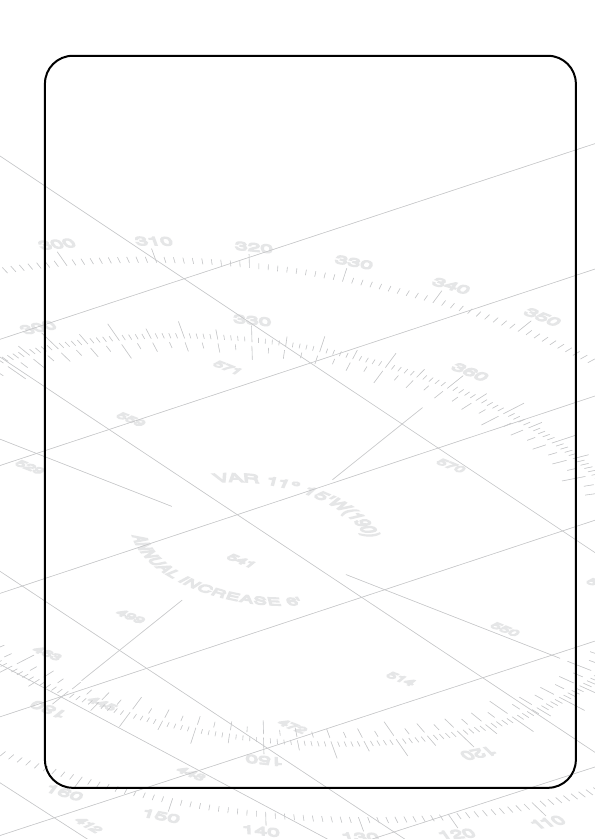
U01UT644AZZ(0)
QUESTIONS?
Contactez-nous au
www.uniden.com ou
appelez 1-800-297-1023.
Imprimé au Vietnam
QUESTIONS?
Visit our website at
www.uniden.com or
call 1-800-297-1023.
Printed in Vietnam